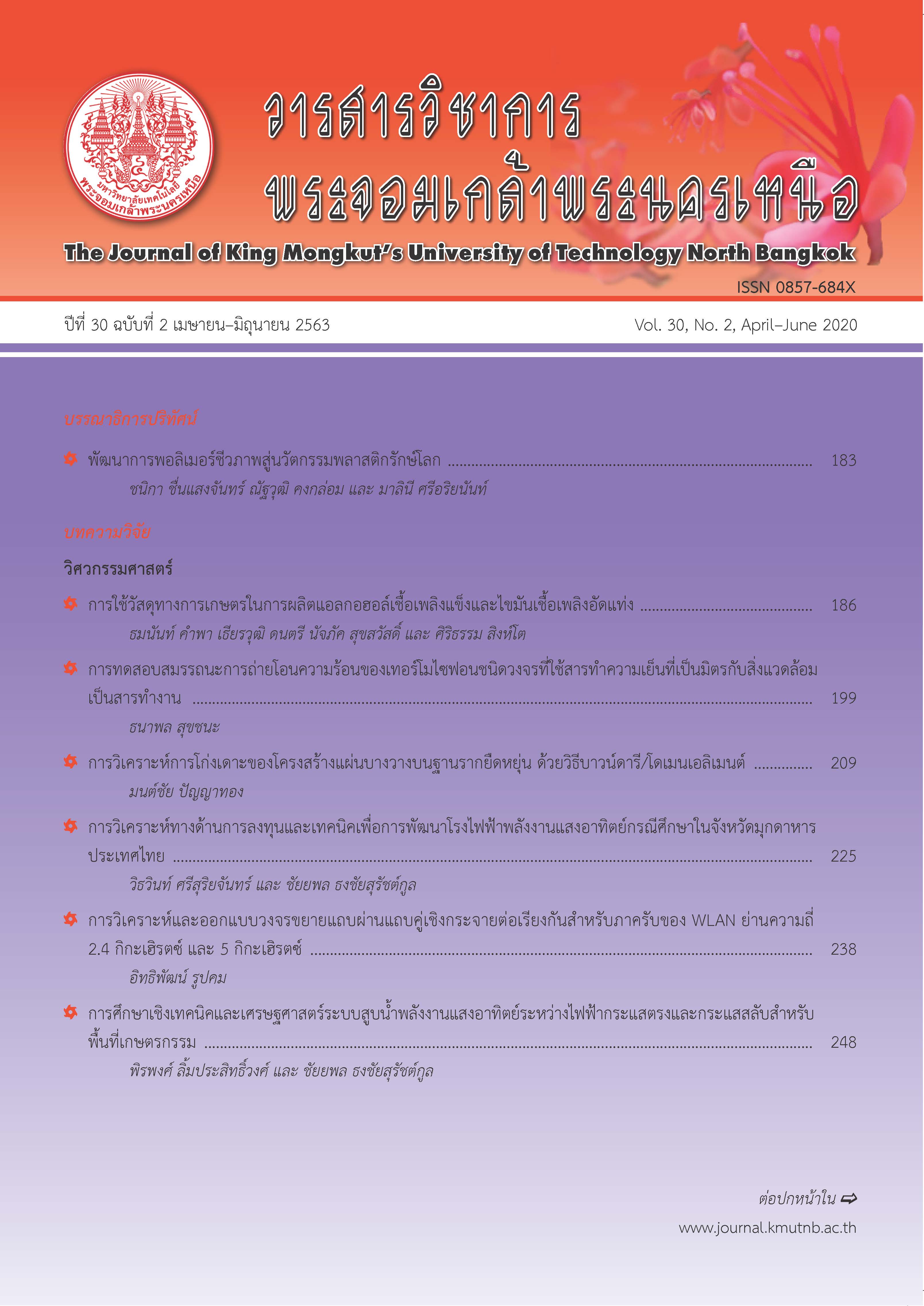ความแกร่งของแผนภูมิควบคุม χ CUSUM และ CP CUSUM โดยใช้ค่า FIR ในการตรวจจับการเปลี่ยนแปลงการกระจายของกระบวนการ
Main Article Content
บทคัดย่อ
การควบคุมคุณภาพเชิงสถิติเกี่ยวข้องกับการตรวจจับสิ่งรบกวนกระบวนการ โดยสิ่งรบกวนนั้นอาจเกิดจากการเปลี่ยนแปลงในค่าเฉลี่ยหรือค่าการกระจายของกระบวนการ งานวิจัยนี้มีวัตถุประสงค์เพื่อศึกษาความแกร่งของแผนภูมิควบคุม χ CUSUM และแผนภูมิควบคุม CP CUSUM โดยการกำหนดค่าเริ่มต้นของตัวสถิติ CUSUM เพื่อให้เกิดการตอบสนองอย่างรวดเร็วจากการตรวจจับการเปลี่ยนแปลงการกระจายของกระบวนการหรือค่า Head Start (HS) เท่ากับ 25%, 50% และ 75% ของขีดจำกัดควบคุม โดยวัดประสิทธิภาพในการตรวจจับการเปลี่ยนแปลงจากค่าความยาวรันเฉลี่ยเมื่อกระบวนการไม่อยู่ภายใต้การควบคุม (Out-of-Control Average Run Length; ARL1) โดยแผนภูมิควบคุมที่มีประสิทธิภาพดีสุดจะให้ค่า ARL1 ต่ำสุด โดยเปรียบเทียบประสิทธิภาพแผนภูมิควบคุม χ CUSUM กับแผนภูมิควบคุม CP CUSUM ในงานวิจัยนี้ศึกษาเมื่อกระบวนการมีการแจกแจงลาปลาซ (0,2) การแจกแจงลอจิสติก (2,2) และการแจกแจงแกมมา (9,1) ผลการวิจัยได้จากการจำลองแบบมอนติคาร์โล 10,000 รอบ พบว่า เมื่อขนาดการเปลี่ยนแปลงในการกระจายของกระบวนการมีขนาดเล็ก แผนภูมิควบคุม χ CUSUM สามารถตรวจจับได้เร็วกว่าแผนภูมิควบคุม CP CUSUM เมื่อใช้กำหนด HS เท่ากับ 75% ของขีดจำกัดควบคุม และมีความแกร่งต่อกระบวนการที่มีการแจกแจงแบบสมมาตรและไม่สมมาตรทุกระดับค่า ARL0
Article Details
บทความที่ลงตีพิมพ์เป็นข้อคิดเห็นของผู้เขียนเท่านั้น
ผู้เขียนจะต้องเป็นผู้รับผิดชอบต่อผลทางกฎหมายใดๆ ที่อาจเกิดขึ้นจากบทความนั้น
เอกสารอ้างอิง
[2] W. A. Shewhart, Economic Control of Quality of manufactured Product. D. Van Nostrand Company, Inc., 1931.
[3] E. S. Page, “Continuous inspection schemes,” Biometrika, vol. 41, no. 1–2, pp. 100–115, 1954.
[4] S. W. Roberts, “Control chart tests based on geometric moving average,” Techmometrics, vol. 42, no. 1, pp. 239–250, 1959.
[5] C. A. Acosta-Mejia, J. J. Pignatiello, and B. R. Venkateshwara, “A comparison of control charting procedures for monitoring process dispersion,” IIE Transactions, vol. 31, no. 6, pp. 569–579, 1999.
[6] K. Tuprah and M. Ncube, “A comparison of dispersion quality control charts,” Sequential Analysis, vol. 6, no. 2, pp. 155–163, 1987.
[7] C. H. Ng, “Development and evaluation of control charts using exponentially weighted moving averages,” M.S. thesis, Faculty of the Graduate College, Oklahoma State University, 1988.
[8] S. V. Crowder and M. D. Hamilton, “An EWMA for monitoring a process standard deviation,” Journal of Quality Technology, vol. 24, no. 1, pp. 12–21, 1992.
[9] T. C. Chang and F. F. Gan, “A cumulative sum control chart for monitoring process variance,” Journal of Quality Technology, vol. 27, no. 2, pp. 109–119, 1995.
[10] J. M. Lucas and R. B. Crosier, “Fast initial response for CUSUM quality-control schemes: Give your CUSUM a head start,” Technometrics, vol. 24, no. 3, pp. 199–205, 1982.
[11] S. H. Steiner, “EWMA control charts with Time-Varying control limits and fast initial response,” Journal of Quality Technology, vol. 31, no. 1, pp. 75–86, 1999.
[12] D. M. Hawkins and D. H. Olwell, “Cumulative sum charts and charting for quality improvement,” Springer Science & Business Media, 1998.
[13] A. Haq, “A new hybrid exponentially weighted moving average control chart for monitoring process mean,” Quality and Reliability Engineering International, vol. 29, no. 7, pp. 1015–1025, 2013.
[14] R. A. Sanusi, M. Riaz, N. Abbas, and M. R. Abujiya “Using FIR to improve CUSUM charts for monitoring process dispersion,” Quality and Reliability Engineering International, vol. 33, no. 5, pp. 1045–1056, 2017.
[15] R. Thitisoowaranon, S. Sukparungsee, and Y. Areepong, “A mixed cumulative sum – Tukey’s control chart for detecting process dispersion,” The Journal of KMUTNB, vol. 29, no. 3, pp. 507–517, 2019 (in Thai).
[16] E. B. Wilson and M. M. Hilferty, “The distribution of chi-square,” in Proceedings of the National Academy of Sciences, 1931, pp. 684–688.

